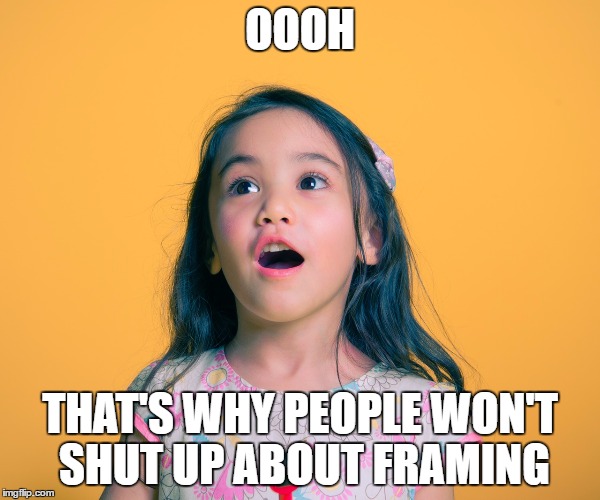Table of Contents
Imagine you’ve got a deadline to meet.
It’s been 15 days out of the 30 you were initially given. You’re working slow and steady; after all, you’ve got two weeks left.
The next morning, you’re talking to a few friends over an early lunch at your favorite restaurant. Everyone is sharing what’s going on in their lives — birthdays, projects, travels, etc., — you mention the project you’ve been working on and how you’re happy with your progress.
Your friend John — always the pessimist — explodes when you tell him you’ve got two weeks to finish.
To him, it’s not two weeks left, it’s two weeks already used up that you can’t get back. It’s two weeks gone which you could’ve used to finish the project.
It’s two weeks you’re using to pursue one thing when you could’ve pursued multiple things.
To John, you’re in trouble and need to pick up the pace.
You leave the lunch date anxious and worried about whether or not you’ll meet the deadline. You’re also thinking about the opportunity cost of not being more productive.
You no longer have two weeks. You’ve burnt two weeks.
What happened here is a classic case of the framing effect. You and John were both expressing the same information but in different ways. John framed it negatively and you framed it positively.
By simply changing the way the problem was presented, you became more risk-averse or more risk-prone.
The framing effect is a powerful tool we’ve been using it for thousands of years to convince and convert.
Many people use framing techniques to make money online by presenting their products or services in the most appealing light.
Keep reading to learn more about framing and how you can use it to stop losing subscribers (and money).
The framing effect is simply the way you present information
The framing effect is an example of a cognitive bias, in which people react to a particular choice in different ways depending on how it’s presented; e.g. as a loss or as a gain. People tend to avoid risk when a positive frame is presented but seek risks when a negative frame is presented. Gain and loss are defined in the scenario as descriptions of outcomes (e.g. lives lost or saved, disease patients treated and not treated, lives saved and lost during accidents, etc.).(source)
The Framing effect is something each and every one of us uses in our everyday lives. We use it to structure arguments with our friends, family, and colleagues. We use the framing Effect when we’re negotiating, talking about problems, or even seducing.
It’s ubiquitous, but many of us don’t even know what we’re doing. Framing was formally identified as a cognitive bias by psychologists
Framing was formally identified as a cognitive bias by psychologists Daniel Kahneman and Amos Tversky.
The Experiment That Got Everyone Talking About Framing
The original experiment asked students to make a decision in a hypothetical situation. They would be required to save lives or allow lives to be lost.
Imagine that the U.S. is preparing for the outbreak of an unusual Asian disease, which is expected to kill 600 people. Two alternative programs to combat the disease have been proposed. Assume that the exact scientific estimate of the consequences of the programs are as follows
When the situation was framed with a chance of saving lives, people were less likely to take risks (positive framing).
If Program A is adopted, 200 people will be saved. [72 percent]
If Program B is adopted, there is 1/3 probability that 600 people will be saved, and 2/3 probability that no people will be saved. [28 percent]
Another Group was given the same cover story, but the loss of life was emphasized and people became more risk prone (negative framing).
If Program C is adopted 400 people will die. [22 percent]
If Program D is adopted there is 1/3 probability that nobody will die, and 2/3 probability that 600 people will die. [78 percent]
Even though the absolute value of all these situations is 200 people surviving, the way each situation was presented had a huge impact on how people decided.
Positive frames create an environment that avoids risk-taking and proactive behavior.
Negative frames create an environment that causes people to take more risk.
Have you ever watched two news stations at the same time?
Watch a station like BBC or CNN while watching Aljazeera.
Compare and contrast what they’re reporting and what they’re not reporting. Also look at how they frame stories that appear on both stations.
It’s eye opening.
Framing has worked in propaganda since man has been able to communicate. It’s not always so overt or even intentional.
Take the controversy over the U.K. ballot to leave the E.U. — The Brexit.
The original wording on the question was:
"Should the United Kingdom remain a member of the European Union?"
It would have prompted a simple yes or no, but complaints were made over the question being biased or confusing. U.K. Prime Minister David Cameron accepted a recommendation to change the wording after the phrasing was tested on potential campaigners, academics, and language experts.
The final wording on the question was:
Get Insightful Content Like This Delivered Straight to Your Inboox
“Should the United Kingdom remain a member of the European Union or leave the European Union?”
The options that led to the fateful decision were:
Remain a member of the European Union
Leave the European Union
(Source)
When you frame a situation a certain way, it forms a reference point. We’re irrevocably tied to reference points which in turn create expectations about outcomes.
Enter the expectation effect, the logical progression of framing
The expectation effect, also known as the subject expectancy effect, is the way behavior, perceptions, and results change as a result of personal expectations or the expectations of those around us.
As soon as you think it’s possible then the belief creates a higher chance of it occurring.
Once you replace negative thoughts with positive ones, you’ll start having positive results. –Willie Nelson.
You’re familiar with many instances of the expectation effect due to positive or negative framing. You just didn’t know what was happening until now.
- Hawthorne Effect: Workers are more productive when given more attention during a test or change to their work environment that’s SUPPOSED to improve productivity. The effect is temporary.
- Pygmalion Effect: Individuals perform better or worse depending on the expectations of their superiors.
- Placebo Effect: One of the most common and widely studied applications of the expectation effect. Patients — based on the belief that treatment will work — receive treatment benefits.
- Halo Effect: Positive feelings in one area cause inconsequential or neutral traits to be viewed positively. In English, positive attitudes associated with a brand’s marketing can spread from one product or service to another aspect or thing. E.g., from using new software to the amount you’re improving your business.
To create the right expectations, your framing of the situation needs to be credible.
In a marketing situation, you can’t hope to build the right expectations if the context you use to frame your solution isn’t congruent.
For example, if you framed your solution as a stripped down version of popular accounting software, your customers won’t expect it to do much more than the basic accounting functions they need to keep their finances in order. If you — for some reason — begin to market it as an all-in-one system, there’ll be problems with their expectations.
If you — for some reason — begin to market it as an all-in-one system, there’ll be problems with their expectations.
To set the right expectations in a group, frame the situation correctly from the beginning.
Grasping the profound impact of how information presentation can shape perceptions is crucial, especially when considering its role in molding consumer choices and elevating the operational flow within organizations.
When leaders adeptly navigate the presentation of tasks and objectives, they harness a pivotal strategy to improve productivity. This method capitalizes on deep-rooted psychological principles to inspire and energize teams, leading to enhanced performance levels and the cultivation of a workspace marked by heightened efficiency and output.
Such strategic insights not only influence decision-making processes but also contribute to a more streamlined and productive environment, demonstrating the nuanced yet powerful ways in which understanding and application converge to drive significant improvements.
Now that you have a very clear understanding of the framing effect, it’s time to use it to become incredibly persuasive.
Four Types of Framing to Bring About Your Desired Action
Loss Framing
Loss framing is also known as the negative framing effect and is simple to understand. If you’ve ever come across a landing page that uses a timer then you know what loss framing is.
Don’t lose $100 every month on groceries, enroll in our exclusive shoppers club.
You don’t want to lose the opportunity to ….
Don’t lose your home because you “didn’t know,” call us today….
The common thread here is fear. Fear of potential loss.
Loss aversion describes people’s tendency to strongly avoid losses to acquiring gain. Keeping your house is more important than buying a new one.
http://youtu.be/0FbwPcsQl1A
Contrary to popular belief, it’s pretty simple to frame novel products. Instead of focusing on only it’s novelty — always a hard sell — you can focus on what it’ll prevent them from losing.
Facebook prevents you from losing contact with your friends and family.
AirBnB prevents you from losing money on huge hotel bills while experiencing a new city.
The video below shows how loss frame and gain frame can be used in medical screening.
http://youtu.be/on2ai4Okp0E
When to use it
The answer depends on your audience and the attitudes they have towards the product. Loss-framed messages work best when the outcome is less certain. It helps remove attention from the ambiguity of the situation and refocus it on what they lose by not choosing you.
In the context of buying your product, you can say “don’t lose $250 every month on insurance. Buy xxx.” Instead of “save $250 every month by buying xxx.”
When possible, present two options.
- Buying your product
- A sure loss
This’ll put them in a risk-taking state of mind and make them more likely to take a chance on you.
The same applies to personal situations. If you’re trying to convince someone to take a less than certain risk — a cross-country road trip. You can frame the argument to highlight all the things they stand to lose like opportunity, experiences, meeting new people, and memories.
Gain Framing
Gain framing is most effective when the benefits of your product, argument, or situation are obvious to the other person. Positive framing is another way to describe it.
Learn a new skill and advance in your career…
Treehouse uses gain framing in their YouTube advertisements.
http://youtu.be/Wnr8LRO7CiA
They have a few different variations, but they’re all showing you the same thing. Someone who was working in a field they didn’t find rewarding took a few classes through Treehouse.
After that, they were able to get high paying jobs. You can do the same if you sign up for a program with Treehouse. You can gain a whole new career and financial freedom.
Dentist’s also use gain framing a lot. Take the video below:
http://youtu.be/MT6WneRYSh8
They’re pretty much selling you the world and then some, but you have to start with your smile (Honestly, I had no idea a smile could do everything under the sun until I watched this video).
When to use it
When the outcome is clear and easy to illustrate, gain framing is the best type of framing effect to use. They’re more persuasive than loss-framed messages because the outcome doesn’t require your prospect to think too much.
For example,
You can easily say get fifty percent more on your tax return when you choose us.
For me, that’s a no-brainer.
Statistical Framing
Statistical framing is arguably the most abused type of framing effect. It relies heavily on data to influence decisions. You can use statistics to create a negatively framed or positively framed message.
I can say my product works 90% of the time while a competitor can say it fails 10% of the time.
Both statements are strictly true, but deliver a very different meaning to the person receiving it.
The video below shows how marketers have been abusing statistics for years.
http://youtu.be/hYy8oBUscmU
Long ago, political aspirants mastered the art of statistical framing. The video below is from the 2012 presidential campaign which pitted Mitt Romney against Barack Obama.
The facts presented are strictly true, but the context only tells a part of the story. Obama presents facts and frames them in the context that best suits him. It fails to tell the whole story.
http://youtu.be/33NT0_MgsVU
Prosecutors are also known for using statistics to frame arguments in what’s known as the prosecutor’s fallacy.
When to Use it
Statistical framing is one of the most versatile framing effects because it’s easily coupled with positive or negative framing.
You can use it in your marketing messages to show social proof in a positive frame e.g., 7,345 smart people just like you have signed up for our newsletter.
Since 7,345 people have already signed up, there must be something there.
You can also use it the same way Mitt Romney and Barack Obama did. It’s always fun to pick a fight with the competition.
Note: never pick a fight with someone who’s considered David when you’re Goliath — we still believe in fair play.
Language and Imagery Framing
Let’s not forget about the imagery and power words you can use to have a profound effect on the frame of your message. Copywriters have been using words and imagery to frame powerful messages for decades.
In The Adweek Copywriting Handbook (formerly known as Advertising Secrets of the Written Word) Joe Sugarman says:
“Your ad layout and the first few paragraphs of your ad must create the buying environment most conducive to the sale of your product or service.”
For your website, that means your words need to sell and your imagery needs to back them up.
I’m a fan of design; I’m always making small tweaks to my website to figure out what’s working best and what’s not. My design is always second to the copy.
You can use words and imagery that appeal to the emotional center of the brain. When your design backs up your imagery, you give a stronger sense of stability, sophistication, and trustworthiness.
If you’re a young exciting clothing brand, you should have words and images that support your branding.
Vibram Kills it with their five fingers campaign.
A stroll through an apple store is very different than a stroll through an AT&T store. Apple gives you a feeling of class and sophistication while AT&T gives you a feeling of utility. Neither is inherently better than the other. It’s the frame created through the imagery and language used.
Drop your visitor into an environment that encourages one behavior and discourages another.
I read the story that Cantor Fine Art created (and watched the video).
They use compelling imagery, music, and a powerful narrative to sell their art.
When to Use It
Imagery and language are staples.
When you can, insert a video of someone using your products. If there’s no video insert images of your product in action.
In lieu of both these options, tell a story about your products and how they made someone — or even you — a better version of themselves.
One of the most powerful ways to use language and imagery to test out framing is when you’re running A/B tests.
Instead of looking at A/B testing as changing the color of a button from red to white, look at it through the eyes of your visitor.
Maybe the problem isn’t the button; the problem may be the way the information is presented or the actual information that’s presented.
For example, someone landed on your wedding dresses page and you’re showing wedding dresses from actual events. Your visitor wants to see the wedding dresses that are in stock. Because of that, she’ll bounce from the page and won’t call.
On the other hand, if you show wedding dresses in stock, she’ll be more likely to call you and discuss alterations or a fitting.
You can also showcase matching wedding invitations to help couples create a cohesive theme for their special day.
Think about those magical “I found the one!” moments in your bridal boutique – they’re pure gold for your marketing.
You could be sitting on a goldmine of emotional testimonials and real-life transformation stories that go way beyond just showing dresses on hangers.
Whether it’s a bride tearing up when she sees herself in her dream dress for the first time, or that perfect shot of a finished alteration that turned a beautiful gown into an absolute showstopper, these are the stories that make other brides-to-be feel like they’re already part of your bridal family before they even walk through your door.
For the dapper groom seeking sartorial splendor, a well-tailored wedding suits for men are an absolute essential – a dashing embodiment of refined elegance and timeless sophistication.
From the sleek lines of a classic tuxedo to the contemporary flair of a slim-fit suit, the options abound, each cut promising to accentuate the groom’s unique style and imbue him with an aura of confidence on his magical day.
Yet, the true artistry lies in the details: the impeccable stitching, the luxurious fabrics, the perfect fit that transforms a mere garment into a statement piece befitting of life’s most momentous occasions.
After all, when love takes center stage, the groom’s attire should be a harmonious accompaniment, a visual symphony that complements and enhances the sublime beauty of the moment itself.
Language and imagery are indispensable. Period.
It’s your turn
We’ve looked at the framing effect from many different angles in this article and you’ve seen how it works in the wild.
Stop reading and take a deep look at the framing of your messages. Are they giving you the most bang for your buck?
Statistics, are you using as well as you should be?
Are you setting the right expectations from the beginning?
Would you benefit more from a positive frame or a negative frame?
Is your language compelling and does your imagery work to back it up?
The framing effect is everywhere and we use it ALL the time — both consciously and unconsciously.
Use the framing effect to your advantage and stop losing your audience and customers.





I love this idea of framing, very powerful!
You have no idea. It’s a very subtle cognitive bias that does a lot of legwork.
interesting read on framing. It is about emotional intelligence
Thanks for reading
Fascinating way of laying out the options to your prospect. Thank you for sharing.
You’re welcome Kenny, in most marketing we see fear used a little too often. It’s not necessary because the framing effect shows us it’s about more than that.
What a power packed post about the framing effect. I heard about it earlier, but not in as many details. Thank you so much for sharing this!
Hey Jelena, I’m glad you found it useful. That’s always the goal right? Once you consciously use framing you’ll notice how powerful perspective can be.
Hey Jelena, I’m glad you found it useful. That’s always the goal right?
Wow! It really blew me away…
Im happy you found it useful
If fear is the driver of a sale due to fear of loss and negative framing enables riskier choices, what power would love have and how would it compare in an experiment?
Framing something in the context of love is akin to positive framing. Love is something we all want to have from our parents, friends, and family. You can use love to frame your message positively. For example: “Unlock a new level of passion in your love life.” It’s a pretty good deal and they stand to gain something
You can also frame it negatively like this: “Don’t let your love life suffer anymore….” they both deal with love – a viseral emotion – but the outcome will still be different depending on on the way you frame the overall message.
Remember, you can make anything take on any meaning. You just need to put it in the right context.